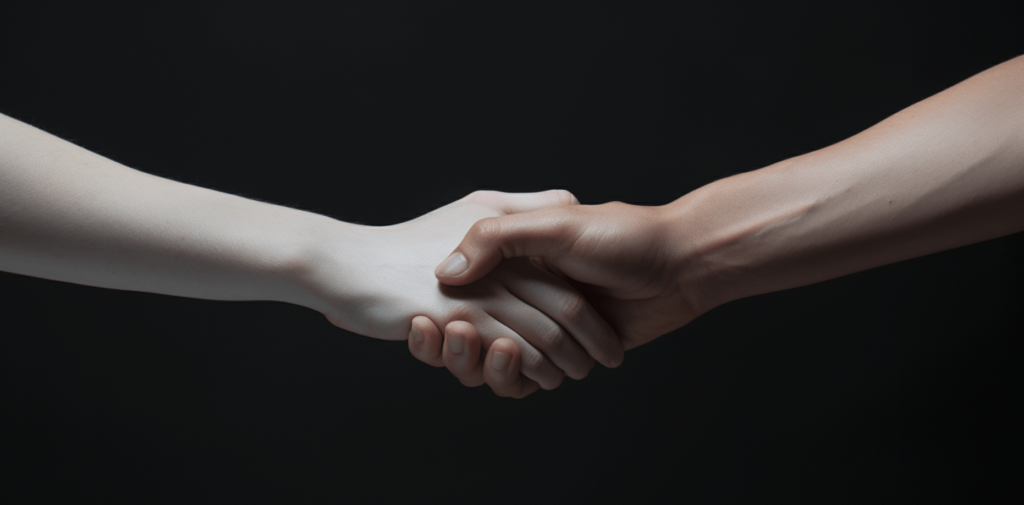Physical touch, while often overlooked, plays a vital role in human communication and bonding. I’ve realized over the years that it’s more than just a basic human need; it’s also a powerful form of communication. From the gentle brush of a hand to an enthusiastic high-five, these simple gestures can convey an array of emotions and messages without uttering even a single word.
The beauty of physical touch lies in its diversity and adaptability. It varies across different cultures, personal relationships, and situations. For example, offering up your hand for a handshake at a business meeting sends quite another message than reaching out for someone’s hand during an emotional time.
I’m excited to dive into this topic further with you all today because understanding the nuances of physical touch can significantly enhance our interpersonal connections. Whether it’s comfort, solidarity, affection or encouragement – there’s probably no emotion that we can’t express through the power of touch.
Understanding the Importance of Physical Touch
I’ve often wondered about the role physical touch plays in our lives. It’s not something we discuss every day, but it has a profound impact on us. From the moment we’re born and cradled in our parents’ arms, to a comforting hand on the shoulder during tough times, physical touch is fundamental to human communication, bonding, and health.
Research reveals that physical touch may have therapeutic effects for people who suffer from stress and anxiety. A study by researchers at UCLA found that holding hands with a loved one can help combat stress-related activity in the brain. Let’s take a look at some key statistics from this study:
| Statistic | Detail |
|---|---|
| Number of participants | 20 couples |
| Activity causing stress | Public speaking |
| Reduction in stress-related brain activity | Up to 34% |
Physical touch doesn’t just alleviate stress; it’s also essential for our overall well-being and even survival. Premature infants who are stroked gain weight nearly 50% faster than those who aren’t according to another research finding.
It’s equally important in maintaining strong emotional connections between people. Think about how you feel when someone gives you a warm hug or simply pats your back reassuringly – it instantly makes you feel closer to them, doesn’t it?
In summary:
- Physical touch alleviates anxiety
- Enhances growth rate in premature babies
- Strengthens emotional bonds
So let’s not underestimate the power of a simple hug or handshake! They’re not just social formalities but vital tools aiding our psychological well-being. I’m excited to dive deeper into this topic as we move forward with this article!
Physical Touch in Different Cultures
In the realm of physical touch, there’s a broad spectrum across cultures. Some societies are quite tactile, while others may be more reserved when it comes to touch.
Consider our friends in Southern Europe and Latin America. They’re often seen as touchy cultures where hugging, kissing on the cheek, or back slapping are common greetings among friends and family. Even during conversations, they might place a hand on your shoulder or arm for emphasis.
On the flip side, we have cultures like Japan and Finland where personal space is highly valued. In these societies, physical contact is usually limited to close family members or intimate relationships. A firm handshake may be the most contact you’ll receive when meeting someone new in these regions.
A few points worth noting about physical touch:
- Middle Eastern men often walk hand-in-hand as a sign of friendship.
- Thais traditionally greet one another with a “wai” – palms together at chest level with a slight bow.
- In India, touching someone’s head can be offensive as it’s considered sacred.
These examples highlight cultural diversity around physical touch norms. It’s key to remember that what might seem friendly or respectful in one culture could potentially be viewed differently in another. So next time you’re traveling abroad or interacting with people from different backgrounds, keep this info handy!
The Role of Physical Touch in Communication
I’m sure we’ve all experienced the power of a simple pat on the back, or a comforting hug during times of distress. Indeed, physical touch plays an indispensable role in our communication, supplementing our words and actions with a more direct, visceral conveyance of feelings and intentions.
Let’s delve into some specifics. In many cultures globally, various forms of physical touch are integral to casual interactions. A warm handshake can foster trust between business partners; a high-five among friends can celebrate shared enthusiasm; even something as subtle as lightly touching someone’s arm during a conversation can enhance connection and empathy.
Physical touch isn’t just about boosting social bonds either – it has been found to have profound effects on our psychological well-being too. Studies indicate that human touch triggers the release of oxytocin – often dubbed the “love hormone” – which helps reduce stress levels, lower heart rate and blood pressure.
Interestingly enough though, not all touches are created equal when it comes to communication:
- Affectionate Touch: These include hugging loved ones, holding hands with your romantic partner or petting your dog.
- Supportive Touch: This could be patting someone’s back in reassurance or giving them an encouraging squeeze on their shoulder.
- Playful Touch: Tickling your children or engaging in friendly wrestling matches falls under this category.
We’re living in an increasingly digital age where physical interaction is often supplanted by virtual exchanges. Yet despite this trend, I believe that nothing can truly replace the nuanced messages conveyed through our fingertips. So next time you’re reaching out (literally) to someone else, remember – your hand might be saying more than you think!
Physical Touch Examples in Daily Life
Each day, we’re surrounded by opportunities to connect with others through physical touch. It’s something so simple, yet it holds such significant power in our daily interactions.
Let’s start with the basics. A firm handshake can set the tone for a business meeting, showcasing confidence and professionalism. It also serves as an initial form of connection between two individuals.
Casual hugs among friends or family are another common example. They offer comfort, convey love, and strengthen bonds. Whether it’s a quick side hug or a full embrace after a long time apart – each has its own unique meaning and impact.
In romantic relationships, touch takes on even deeper significance. Holding hands signifies unity and closeness while cuddling can be a source of comfort and intimacy.
High-fives and fist bumps are popular among sports teams or groups of friends celebrating small victories. These gestures express camaraderie and shared excitement.
Lastly, consider the nurturing touch of parents towards their children – from gently stroking their hair to soothe them to sleep to playful tickling that elicits squeals of joy.
Here’s an overview:
- Handshakes: Professionalism
- Hugs: Comfort & Love
- Holding Hands & Cuddling: Intimacy in Romantic Relationships
- High-Fives/Fist Bumps: Camaraderie & Excitement
- Parental Touch: Nurturing
So you see, there’s more than meets the eye when it comes to physical touch in daily life!
How Physical Touch Affects Human Relationships
Physical touch is a powerful tool that plays a significant role in human relationships. It’s more than just handshakes, hugs, or pats on the back. In fact, it’s one of our primary ways of communicating empathy, suggesting comfort and building connections with others.
When we experience positive physical contact like a hug from a loved one or a pat on the shoulder from a friend, our bodies respond by releasing oxytocin. This hormone, often known as the “love hormone,” helps to create feelings of trust and bonding. Let me share an interesting fact here – according to research conducted by the University of Miami’s School of Medicine, adults who receive regular physical touch are generally healthier and less stressed than those who don’t.
- Table 1: Impact of Physical Touch
| Positive Touch | Outcome |
|---|---|
| Hug from Loved One | Release Oxytocin (Trust & Bonding) |
| Pat on Shoulder from Friend | Lower Stress Level |
Now let’s talk about how physical touch impacts romantic relationships specifically. Do you know that couples who have higher levels of physical affection tend to have happier and longer lasting relationships? Yes indeed! Studies show that non-sexual touches such as cuddling or holding hands can increase satisfaction in romantic relationships significantly.
But no conversation about physical touch would be complete without acknowledging its potential downside too. Not all touches are welcome or consensual. Unwanted or inappropriate touch can lead to discomfort and distress. Hence, it’s critically important for everyone to understand boundaries and respect personal space.
In summary then, whether it’s comforting someone during tough times with an arm around their shoulders or sharing joy through high-fives after a victory – physical touch has deep roots in human communication and emotional well-being.
Ways to Incorporate More Physical Contact in Your Routine
Let’s dive right into how one can incorporate more physical contact into their daily routine. It’s not as complicated as it may seem, and a few simple changes can make a big difference.
Starting your day with a hug is one easy way. I’ve found that giving or receiving a warm hug from someone close to you can be an excellent start to the day. It sets the tone of positivity and connection for the rest of your day.
Another option is incorporating touch into casual conversations. If you’re comfortable with the person you’re talking to, a light touch on their arm or shoulder can add depth and warmth to your interaction. Remember, though, always respect boundaries.
On top of this, consider joining activities that involve physical contact – such as dancing classes or group sports. These serve dual purposes; they keep you physically active and provide an environment where physical touch is natural and expected.
When it comes down to personal habits, try practicing self-touch more often too. This could mean applying lotion slowly, giving yourself a massage when tired or simply hugging yourself tight when feeling low. Not only does this increase your comfort level with touch but also boosts self-love.
Ultimately it’s all about understanding consent and comfort levels while exploring ways of increasing physical touch in our lives. Here are some ideas:
- Start your day with a hug
- Incorporate touch during conversations
- Join activities involving physical contact like dance class or sports
- Practice regular self-touch
Remember that everyone’s comfort levels regarding touch are different so always ensure mutual consent before initiating any form of physical contact.
Positive Effects and Benefits of Regular Physical Interaction
I’m a strong believer in the power of physical touch. It’s not just about the feel-good factor, it’s proven to have numerous benefits on our health and wellbeing.
Firstly, physical interaction can help reduce stress. A reassuring hug, a pat on the back, or even a simple handshake can trigger the release of oxytocin – often dubbed as ‘the love hormone’. This hormone is known to decrease levels of cortisol – the notorious stress hormone. So next time you’re feeling stressed out, don’t underestimate the calming influence of a comforting touch!
Moreover, regular touch has been found to boost our immune system too. According to studies conducted by Carnegie Mellon University in 2015:
| Year | Study |
|---|---|
| 2015 | Participants who received more hugs and had greater social support were less likely to catch colds when exposed to the virus |
It may sound surprising but it’s true! The warmth and positivity from physical interaction seem to work wonders for our health.
Physical contact isn’t only beneficial for adults either; it plays an essential role in child development too. Children who receive ample amounts of affectionate touch tend to have better cognitive abilities and emotional health.
Now let’s talk about relationships. Regular physical connection like holding hands or cuddling fosters trust and strengthens bonds between couples. It communicates love without words, creating a sense of security that goes beyond verbal communication.
Lastly, it contributes towards better mental health as well. Touch is known to alleviate symptoms of depression and anxiety by promoting feelings of safety and reassurance.
So there you go! These are just some ways how regular physical interaction can enhance your life:
- Reduces stress
- Boosts immunity
- Helps child development
- Strengthens relationships
- Promotes good mental health
It’s clear that humans thrive on touch; we’re wired for connection. So let’s not overlook the importance of this basic human need and make sure to incorporate more positive touch in our lives. After all, a little hug can go a long way!
Conclusion: Embracing the Power of Touch
I’ve spent this entire article examining the myriad ways physical touch impacts our lives. Yet, it’s impossible to fully capture its significance in a few paragraphs. Let’s try though.
Physical touch is more than just a simple sensory experience—it connects us in profound ways. It bridges gaps between individuals and strengthens bonds in relationships.
Think about how comforting a warm hug can be, or how reassuring a pat on the back feels when you’ve worked hard on something. They’re not just gestures—they carry weight and meaning that words often can’t convey.
The magic lies in its universality. Regardless of where you come from or what language you speak, physical touch is understood by all.
That being said, let’s not forget about consent—it’s as crucial as the act itself. Always respect personal boundaries and remember that everyone has different comfort levels with physical contact.
Incredible, isn’t it? The power that resides within such simple acts we typically take for granted—handshakes, hugs, pats on the back—and yet they’re so influential.
For those of you who are eager to embrace the power of touch more consciously in your own life, here are some suggestions:
- Start small: A handshake or high-five can go a long way.
- Show affection: Give loved ones hugs and kisses (with their permission).
- Be supportive: Offer comforting touches like hand-holding during tough times.
There it is—the world at your fingertips! Now get out there and spread some positive vibes through your touch!
By recognizing and harnessing this power—I’m confident—we’ll create deeper connections with one another. After all, we’re social creatures deserving love and connection—a fact I’m reminded of every time I hold someone’s hand or share an encouraging pat on their shoulder.
So here’s my final thought – use your hands wisely because you never know whose day you could be brightening with a simple touch.



